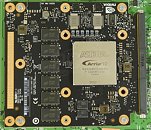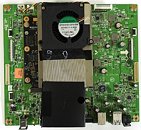Monday, June 25th 2018

NVIDIA G-Sync HDR Module Adds $500 to Monitor Pricing
PCPer had the opportunity to disassemble the ASUS ROG Swift PG27UQ 27", a 4K 144 Hz G-Sync HDR Monitor and found that the G-Sync module is a newer version than the one used on 1st generation G-Sync monitors (which of course do not support 4K / 144 Hz / HDR). The module is powered by an FPGA made by Altera (Intel-owned since 2015). The exact model number is Arria 10 GX 480, which is a high-performance 20 nanometer SoC that provides enough bandwidth and LVDS pins to process the data stream.
The FPGA is sold in low quantities for $2000 at Digikey and Mouser. Assuming that NVIDIA buys thousands, PCPer suggests that the price of this chip alone will add $500 to monitor cost. The BOM cost is further increased by 3 GB of DDR4 memory on the module. With added licensing fees for G-SYNC, this explains why these monitors are so expensive.
Sources:
PCPer Review, Altera Product Page
The FPGA is sold in low quantities for $2000 at Digikey and Mouser. Assuming that NVIDIA buys thousands, PCPer suggests that the price of this chip alone will add $500 to monitor cost. The BOM cost is further increased by 3 GB of DDR4 memory on the module. With added licensing fees for G-SYNC, this explains why these monitors are so expensive.


94 Comments on NVIDIA G-Sync HDR Module Adds $500 to Monitor Pricing
One of my PCs is hooked up to my TV every now at then, and there's always a heartbeat between moving the mouse physically, and action taking place on the screen.
Head on over to www.rtings.com and read through some of their reviews and look at the response time section. They are no nonsense and will give you just the facts on the TVs.
FYI - just venting
news.xbox.com/en-us/2018/04/20/may-xbox-update/
G-Sync - The term "G-Sync" oddly is still used even when the user turns off G-Sync. A "G-Sync" monitor can be used 2 ways. Using Adaptive Sync to sync frame rates is only one of them. The sync technology provided has its most noticeable impact from 30 to 75ish fps at which point users will often choose to switch to ULMB, the usage of which requires G-Sync to be disabled. The nVidia hardware module provides the back light strobing required for motion blur (MBR) reduction.
Freesync - Freesync provides a similar adaptive sync technology and again has its most significant impact from 40 to 75ish fps. Like G-Sync it continues to have an impact above 75 fps, but in both instances it trails, off quickly. But here's the kicker. Freesync has no hardware module and is therefore incapable of providing Motion Blur Reduction technology (backlight strobing) which virtually eliminates ghosting. Some monitor manufacturers have provided such technology on there own ... problem is there's a myriad of designs and results vary. And when it's done well, the cost of providing the necessary MBR hardware, erases Freesync's cot advantage.
If you are running a nVidia top tier card on a Acer XB271HU or Asus PG279Q and don't have G-Sync disabled and instead using ULMB, you're missing out. When the new 4k 144 hz versions of those monitors drop, I'd expect users will be bouncing back between each setting depending on frame rates.
I use G-Sync mode, i have tried ULMB mode but meh, i still prefer G-Sync mode.
Don't knock it till you try it.
www.rtings.com/monitor/guide/freesync-amd-vs-gsync-nvidiaStop lying. You can use G-Sync monitors with AMD cards.
But $500 for a GSync2 module is actually great news. It means the death of GSync is that much closer, so we can settle one one standard, like, you know, sane people.
I don't often agree with Vya, but making a big fuss of a 16ms delay when your reaction times is 15x that is a little out there.
The only time that would make a difference would be if your mouse movement lagged perceivably behind. But you can test that on the desktop: it doesn't. The only reason these things are advertised is because professional monitors value color accuracy above everything else, thus they don't tend to use overdrive and can have latencies in the 30-50ms (or worse). That could cause the mouse to lag a little behind fast movements.